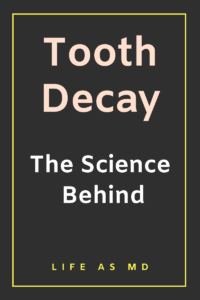Tooth decay (Dental caries) is defined as a microbiological disease of the hard structure of teeth, which results in localized demineralization of the inorganic portion and destruction of the organic substances of the tooth.
What are the causes of tooth decay?
Dental caries is caused by a specific strains of bacteria which accumulate on the enamel surface, where they elaborate acidic and proteolytic products that demineralize the surface and digest its organic matrix.
But caries does not result from a single factor; rather, it is the outcome of the complex interaction of pathologic and protective factors.
These are
- Dental plaque is a structured, resilient yellow-grayish substance that adheres tenaciously to the tooth which is composed primarily of microorganisms (70-80%). Predominantly streptococcus mutans.
- Cariogenic foods – these are foods that can be converted to lactic acid. These are carbohydrates predominantly monosaccharides and disaccharides.
- Hyposalivation – saliva has many benefits in the oral cavity like washing away food debris, buffering of acid produced by the bacteria, remineralization of the tooth, and also has an antibacterial effect. So a decreased amount of saliva predisposes to dental caries.
- Condition of the tooth – abnormal structure and position of the tooth, like a deep pit, fissure, and malposed tooth interferes with the physiological cleaning mechanism of the teeth. And that causes accumulation of dental caries and subsequent formation of dental caries.
- Poor oral habit – these allow the dental plaque to have sufficient time to elaborate carbohydrates and convert them to lactic acid and the subsequent formation of dental caries.
Classification of dental caries
There are many ways of classifying dental caries. Among the common ones are: –
Based on the surface of involvement.
- Smooth surface caries
- Pit and fissure caries, and
- Root caries
Based on cavity preparation design, it classifies into six classes. These are: –
- I: Pit and fissure caries occur in the occlusal surfaces of premolars and molars, the two-thirds of the buccal and lingual surface of molars, the lingual surface of incisors.
- II: Caries in the proximal surface of premolars and molars.
- III: Caries in the proximal surface of the anterior (incisors and canine) teeth and not involving the incisal angle.
- IV: Caries in the proximal surface of anterior teeth also involving the incisal angle
- V: Caries on the gingival third of facial and lingual or palatal surfaces of all teeth.
- VI: Caries on incisal edges of anterior and cusp tips of posterior teeth without involving any other surface.
What are the symptoms?
Normally dental caries is asymptomatic until it reaches deep dentin. Beyond that, the patient starts to experience dentinal hypersensitivity which is intense short-lasting pain upon external stimulation by heat or cold. When caries reaches the pulp the patient starts to feel sharp continuous dental pain.

How to diagnose tooth decay?
There are various methods of diagnosing dental caries. Among the common ones are =
1. Tactile examination – In this method explorer has been used for the tactile examination of the tooth for a long time. The explorer is used to detect softened tooth structure. Since demineralization is a process that does not always involve sufficient softening of the enamel to be detectable by an explorer. When an explorer sticks, it’s usually a good indication that there is decay beneath; however, when it does not stick, it does not necessarily mean that decay is not present.
2.Visual examination – Visual examination for diagnosing dental caries is a very popular method. It is based on the criteria such as cavitation, surface roughness, opacification, and discoloration of clean and dried teeth under an adequate light source.
3. Ultraviolet illumination – It is an advance in the visual examination method. Ultraviolet light increases optical contrast between the carious area and the surrounding healthy tissue. e natural fluorescence of enamel as seen under UV light is decreased in areas of less mineral content such as a carious lesion, artificial demineralization, and developmental defects. e carious lesion appears as a dark spot against a fluorescent background.
4. Radiographic Method of Diagnosis – Radiographs play an important role in the diagnosis of dental diseases. Dental radiographs provide useful information for diagnosing carious lesions. Although radiographs may show caries that are not visible clinically, the minimal depth of a detectable lesion on a radiograph is about 500 μm. The clinician should be familiar with normal radiographic landmarks. The most commonly used types of radiographic methods are –
- Intraoral periapical radiography
- Bitewing radiography
What are the common complications?
- Pulpitis – inflammation of the pulp
- Periapical cyst – formation of a cyst at the root tip
- Periapical abscess – formation of an abscess at the root tip.
- Osteomyelitis of the jaws.
- Cellulitis of the facial soft tissues.
What are the treatment options?
- Restoration – it is a procedure that is done if the pulp is vital.
- Root canal treatment – it is a procedure which is done in a non-vital tooth in which the pulp is completely extirpated from the pulp chamber and from the pulp canal and field with biologically inert material (gutta percha). And the pulp chamber is filled with proper restorative material.
- Extraction – it is a procedure done when the pulp is grossly decade beyond the possibility of restoration.
How to prevent tooth decay?
- Oral hygiene – maintaining proper oral hygiene like tooth brushing and flossing
- Dietary measures – restriction of carbohydrates especially monosaccharides and disaccharides and avoiding sticky refined foods.
- Fluoride application – in office or home-based application of fluoride.
Watch the video to summarize about tooth decay.

Pingback: What are the 4 Stages of Pneumonia? - Life As MD